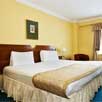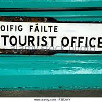Waterford
Waterford is the oldest city in Ireland (founded by Vikings in 324AD) famous for its crystal ware and intriguing medieval history. Located on the River Suir, Waterford was once one of the most important European ports in times past. Today, Waterford still maintains its 'small Irish town' feel, and has a much more relaxed vibe than the larger cities, whilst still providing for most traveler's tastes. Appealing most, perhaps, to interests including history, culture, music and arts. Waterford, like most Irish towns, has a lot of pubs.
Situated in the south east, the city has one of the warmest climates in Ireland, getting on average an extra hour of sunshine each day. The seaside town of Tramore is located just south of the city and has a 5 km long beach, and is also a popular surfing spot.

Image: Waterford, Ireland
The Untaken City
The city motto Urbs Intacta Manet Waterfordia ("Waterford remains the untaken city") was granted by King Henry VII of England in 1497 after Waterford refused to recognise the claims of the pretenders Lambert Simnel and Perkin Warbeck to the English throne. Waterford was subjected to two sieges in 1649 and 1650, during the Cromwellian conquest of Ireland. It withstood the first siege but surrendered during the second siege on 6 August 1650.
Reginald's Tower is the oldest urban civic building in Ireland, and the oldest monument to retain its Viking name. To this day, it remains Waterford's most recognisable landmark. It is believed to be the first building in Ireland to use mortar. The River Suir, which flows through Waterford City, has provided a basis for the city's long maritime history. The place downriver from Waterford where the Nore and the Barrow join the River Suir is known in Irish as Cumar na dTrí Uisce ("The confluence of the three waters"). Waterford Port has been one of Ireland's major ports for over a millennium. In the 19th century, shipbuilding was a major industry. The owners of the Neptune Shipyard, the Malcomson family, built and operated the largest fleet of iron steamers in the world between the mid-1850s and the late 1860s, including five trans-Atlantic passenger liners.
Waterford Crystal
Today, Waterford is known for Waterford Crystal, a legacy of the city's former glass making industry. Glass, or crystal, was manufactured in the city from 1783 until early 2009, when the factory there was shut down after the receivership of Waterford Wedgwood plc. The Waterford Crystal visitor centre in the Viking Quarter opened in June 2010 after the intervention of Waterford City Council and Waterford Chamber of Commerce.
The Viking Triangle
The city of Waterford consists of various cultural quarters, the oldest of which is known as Viking Triangle. This is the part of the city surrounded by the original 10th century fortifications, which is triangular in shape with its apex at Reginald's Tower. Though this was once the site of a thriving Viking city, the city centre has shifted to the west over the years, and it is now a quiet and tranquil area, dominated by narrow streets, medieval architecture, and civic spaces. Over the past decade, a number of restaurants have opened in High Street and Henrietta Street, taking advantage of the charming character of the area. Much of Waterford's impressive architecture is to be found in the 'Viking Triangle'.




